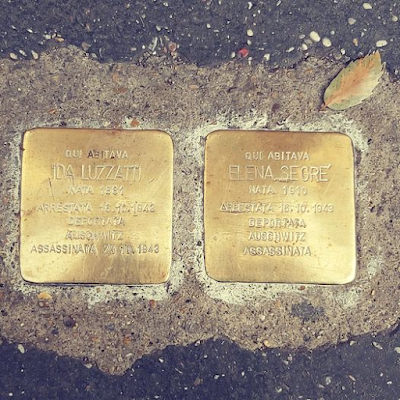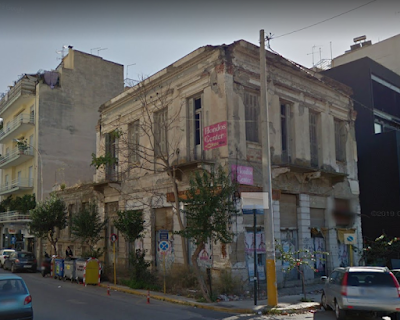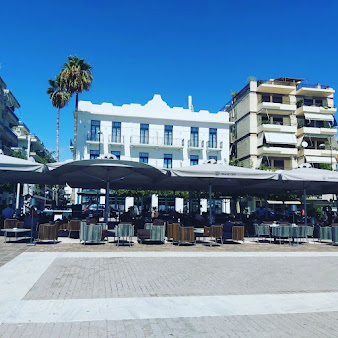Okay so we didn't zip through Rome on a Vespa as did Audrey Hepburn and Gregory Peck in the iconic romance movie, Roman Holiday, set in this Italian city, in 1953. We are a tad too old for that.
 |
| Roman Holiday movie 1953 |
But we did zip through the town, seeing as much as possible during our day and a half here. You can cover a lot of territory on foot when the weather cooperates, and the tourist numbers are low.
 |
| No crowds at the Spanish Steps |
Our Roman Holiday was part of a week-long trip to Italy we took in November. One of the side benefits, we've learned, to expat living in Europe is the ease of travel to other countries. No longer must we pack for multiple weeks to make the cost of the trip worthwhile as we did when we were coming from the far western side of the United States.
We made the 3.5-hour drive from our home in the Peloponnese to the airport and then traveled between Athens and Rome in less than two hours. Our trip was prompted by a two-for-one seat sale offered by Greece's national carrier, Aegean Airlines.
 |
| Train travel is such a treat in Italy |
And traveling off-season as November is here, we could travel without a set itinerary. Frankly, we weren't sure how much time, if any, we would spend in Rome when our flight from Athens arrived on a Saturday evening. We were catching two trains as soon as we collected our checked luggage; one to take us from the airport into Roma Termini (the main train station) and there, catching another to Florence where we were booked for five nights.
Admittedly unstructured travel isn't for everyone. I have friends who create Excel spread sheets and plan their trips down to the nano-second. That isn't our style of travel though - at least during the low-seasons as this is in Europe. The likelihood of getting accommodations on short notice is good and we like the flexibility to change plans if something more interesting comes along.
 |
| Train to Rome via the Italian countryside |
We'd considered some charming Italian villages but when you live in a charming Greek village, I have to admit, the call of the big city won out.
Another travel trait of ours is to find a hotel with as much history as possible, and we'd succeeded in Florence so hoped for the same in Rome. The Scout went to work while in Florence, tapped into our accumulated hotel loyalty points (Marriott Bonvoy) and used points to pay for a hotel stay in Rome that we would never have paid the price for otherwise. Using points, our cash outlay was for the cost of the nightly city tax. As our travels have reminded us of time and time again, those airline and hotel loyalty programs do pay off.
The Grand Hotel Flora
 |
| The Grand Hotel Flora |
When the cab pulled into the semi-circular drive and the doorman greeted us at the stately old Grand Hotel Flora, located across the street from the Borghese Gardens, I knew The Scout had hit on another winner.
 |
| Our hotel and the city walls from Harry's Bar |
This place literally oozed history. Construction on the building had begun in 1905 when the Borghese family had commissioned a vacation villa. Economic woes prompted a change of plans, the structure was sold, and the new owner decided it would be a hotel. Designed by a Vatican City architect, the hotel opened as the Pension Flora in 1907 on Rome's famed Via Vittorio Veneto.
 |
| The stairwell from the seventh floor |
The site on which it was built is said to have been - back in Roman times - an area of 'Dolce Vita' (sweet life) with Caesar among the villa owners in the neighborhood.
 |
| Roman walls and Borghese gardens from our room |
By the 1930's it was a modern day 'dolce vita' destination attracting the rich and famous.
 |
| Stolpersteine, or 'stumbling stones' commemoration |
Sadly, like many of Europe's grand hotels, the hotel's dark period was when it was occupied by the Gestapo during World War II.
Here, I must add a side story illustrating that it is impossible to travel in Europe and not be reminded of World War II's impact, as happened during our short stay in Rome:
We were walking to the Spanish Steps from the hotel when we noticed two small, four-inch by four-inch markers, embedded in the sidewalk in front of a building just a few blocks away. The names are of a mother and daughter who'd been living in the apartment, were arrested, deported, and died in Auschwitz.
I posted the photo above on FB during our stay in Rome and thanks to a number of friends who commented on it, learned they are called Stolpersteine, or 'stumbling blocks' a commemoration effort begun in 1992 for victims of the Holocaust. I will be keeping an eye out for similar markers as we travel around European cities in the future.
[Note: For those wanting more history, I Googled the names of the women and found their story and the Stopersteine information is from Wikipedia.]
 |
| The Scout at Harry's Bar Roma |
It was Frederico Fellini's 1960 satirical comedy film, La Dolce Vita, that is credited with bringing back the sweet life to the hotel as well as the Via Veneto on which it sits. And sweet life it is with major eateries, bars and other hotels within a few minutes of where we stayed. One such bar, featured in the film, was Harry's Bar - just across the street from the hotel. As they say, 'when in Rome, do as the Romans do' -- so we did! We sipped a glass of wine at the famous place both nights we were in town.
It, too, has an interesting history as it was opened in 1918 by an American woman who called it the Golden Gate for her city by the bay back home, San Francisco.
 |
| Stone, or umbrella pines, of Rome in Borghese gardens |
We loved being near the Borghese Gardens a place one could stroll for hours. However, we were unable to visit the Borghese Gallery as tickets were booked out for a couple of days. That was no problem though as were strolled its outside sculpture garden!
 |
| Borghese Gallery - next time! |
We are now back at our Stone House on the Hill enjoying a relatively mild winter so far in this slice of the Peloponnese. We are getting ready for another quick getaway, and I will end this post with a teaser on where we are heading. Want to take a guess by looking at the photo below?
 |
| The next getaway destination is. . . |
So how do you like to travel? Everything planned in advance or just setting off for an adventure. Tell us in the comments below or shoot us an email! Wherever your travels take you we hope you stay safe and well and are back here with us soon! As always, thanks much for the time you spend with us ~

.png)













































